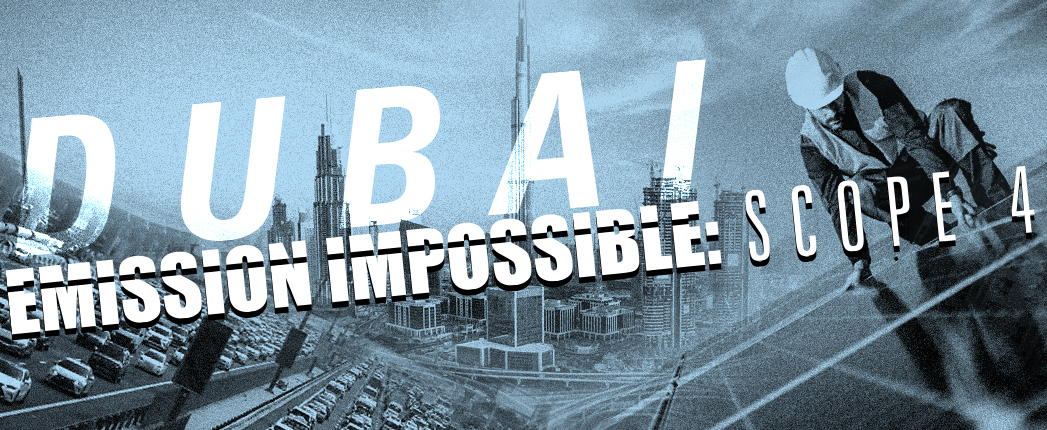
When you think of Dubai, it is unlikely sustainability is the first thing that comes to mind. More likely will be the ultra-modern architecture, vast shopping malls, indoor ski slopes, luxury hotels and gas-guzzling SUVs, all air-conditioned 24 hours a day, 365 days a year, to a temperature just above freezing.
On paper, things certainly don’t look good for the environmental impact of this desert city state on the coast of the Persian Gulf. The United Arab Emirates, of which Dubai is a part, ranks fifth-highest for carbon dioxide emissions per capita. Country Overshoot Day in the emirates this year was March 13, exactly the same day as Canada and the United States, and a week after I had the opportunity to visit. There are certainly more environmental rankings and metrics that could paint a grim picture of Dubai’s sustainability.
Believe it or not, all that is set to change. Plans are in motion to make Dubai the world’s most sustainable city by 2050 and targets for the emirate to be carbon neutral in the same year. To reach this goal, the government has launched many green initiatives, some of which I saw myself. Notably, the Sustainable City Project, a 46-hectare net-zero-energy property development, and many districts at Dubai Expo, which was fully focused on sustainability as entire event.
While I was there with my family, we of course made our way up the Burj Khalifa – the tallest building in the world and a spectacular film location, notably in Mission: Impossible 4 – Ghost Protocol, starring Tom Cruise. As we ascended, I wondered how much CO2 emissions would have been avoided if this building didn’t exist. Would it be possible to calculate avoided emissions, or would it be a mission impossible? More importantly, why should businesses even be concerned with calculating these ghost emissions?
Businesses are increasingly driven to estimate and make claims about the greenhouse gas emission impacts of their companies, products and services. While they measure their Scope 1, 2 and 3 emissions according to the standard of the Greenhouse Gas Protocol, in order to calculate their carbon footprint, there is now a new concept gaining importance, namely Scope 4 emissions.
>Read more about the Greenhouse Gas Protocol here.
Scope 4 describes those emissions that can be avoided through the use of a particular or alternative product or service. If a corporation improves the efficiency of a product or service, this reduces the emissions arising through its use. However, these emission savings can be concealed, by, for example, the growing popularity and sales of that product or service.
For example, an electric toaster manufacturer develops a more efficient toaster that reduces the average CO2 footprint per slice of toast. Nevertheless, emissions from this toaster actually increase as more customers buy it. This results in an increase in the manufacturer’s total Scope 3 emissions.
Even though the toaster manufacturer has innovated and increased efficiency on an individual unit basis, this essentially results in a higher corporate carbon footprint. The company would nonetheless want to track its progress in avoiding emissions, which would have otherwise occurred if it had not invested in research and development to improve its efficiency.
In other words, as a result of optimizing the efficiency of the toaster, CO2-emissions from making toast would have been higher were it not for its product design innovation and manufacture.
We might need the tracking, accounting and reporting of such avoided Scope 4 emissions in the future to better address corporate climate action, of course without deducting or offsetting in any way the combined Scope 1, 2 and 3 emissions of companies.
Some companies already quantify, report and set goals around the climate benefits of their products and services. For example, of the more than 1,100 companies that report to the CDP (formerly known as the Carbon Disclosure Project), two-thirds say the use of their products directly enable greenhouse gas emissions to be avoided by a third party. However, there is still no international standard or consistent terminology to describe avoided emissions. Individual companies and industry initiatives are left to develop their own approach, which leads to inconsistency.
It is essential to ensure that such claims organizations are making that state their product reduces emissions are credible.
The Greenhouse Gas Protocol principles plan to account for such Scope 4 emissions in the future and develop a structure, formalized process and framework for estimating and publicly reporting the comparative emission impacts of products. The Dos and Don’ts to companies for avoiding greenwashing and increasing credibility must include:
End users and customers need to understand the benefits of products that reduce emissions, but they also need to have the assurance and confidence that avoided emission claims are credible. Only then is it possible to create the necessary market pull for innovative, efficient and low-emission products and services.
The current reporting approach is focused on an organization’s progress in reducing emissions. But reducing carbon footprints is only part of the solution. There may be situations where the development of new products or processes temporarily increases a company’s emissions, but would reduce emissions associated with the use of such products in the long term. If we penalize companies that temporarily increase emissions to develop high-efficiency products, they’ll be less inclined to innovate, even though the emissions avoided in the long term could be greater than those generated during the development phase.
Companies – especially lubricant companies – can play a key role in developing and promoting products and services that avoid emissions. (I previously reflected on this as “fingerprint” in my “5 Fs model” in an article and webinar in 2021).
With a firm understanding of Scope 4, organizations can develop emissions scenarios that clearly outline the potential outcomes of developing a more sustainable product and improving transparency for stakeholders. While it is a challenge to quantify avoided emissions, they should still be embedded in an organization’s reporting in order to create a holistic view of its greenhouse gas inventory.
Back to Dubai. After admiring the breathtaking views from the top of the Burj Khalifa, I wanted to know just how unsustainable this building must be and how much energy it uses to keep its 163 floors illuminated and ice cold. I was surprised again to discover that it’s one of the greenest skyscrapers in the world. Solar panels heat 140,000 liters of water per day, saving 3,200 kilowatts of electricity per day, and condensation from air conditioning is recycled as irrigation water for the surrounding landscaping.
Becoming the world’s most sustainable city by 2050 looks like mission possible for Dubai.
STAY SuSTAYnable!

Apu Gosalia
Adviser, partner and honorary lecturer in sustainability strategy

Sorry, a technical error occurred and we were unable to log you into your account. We have emailed the problem to our team, and they are looking into the matter. You can reach us at cs@lubesngreases.com.
Click here link to homepage